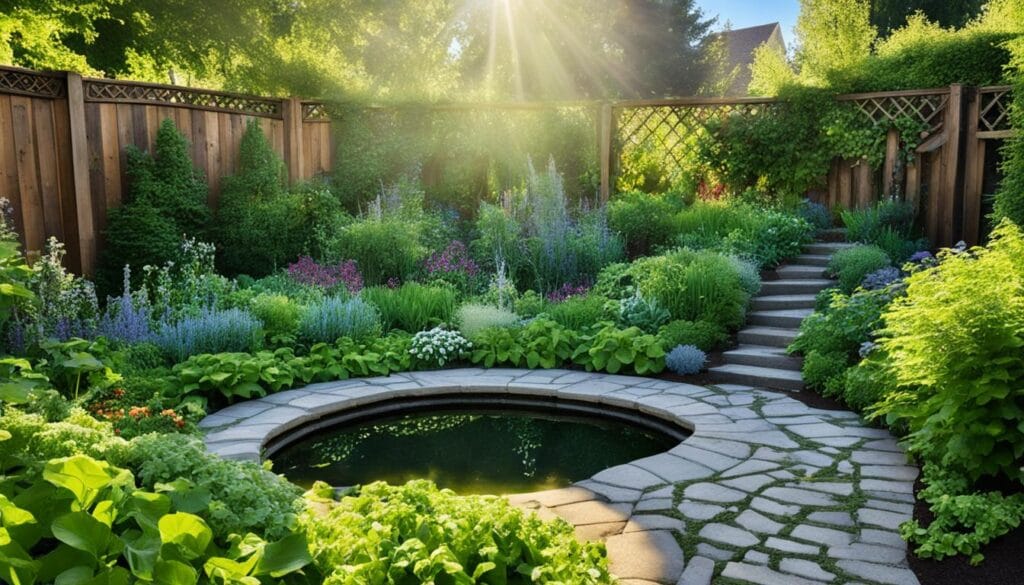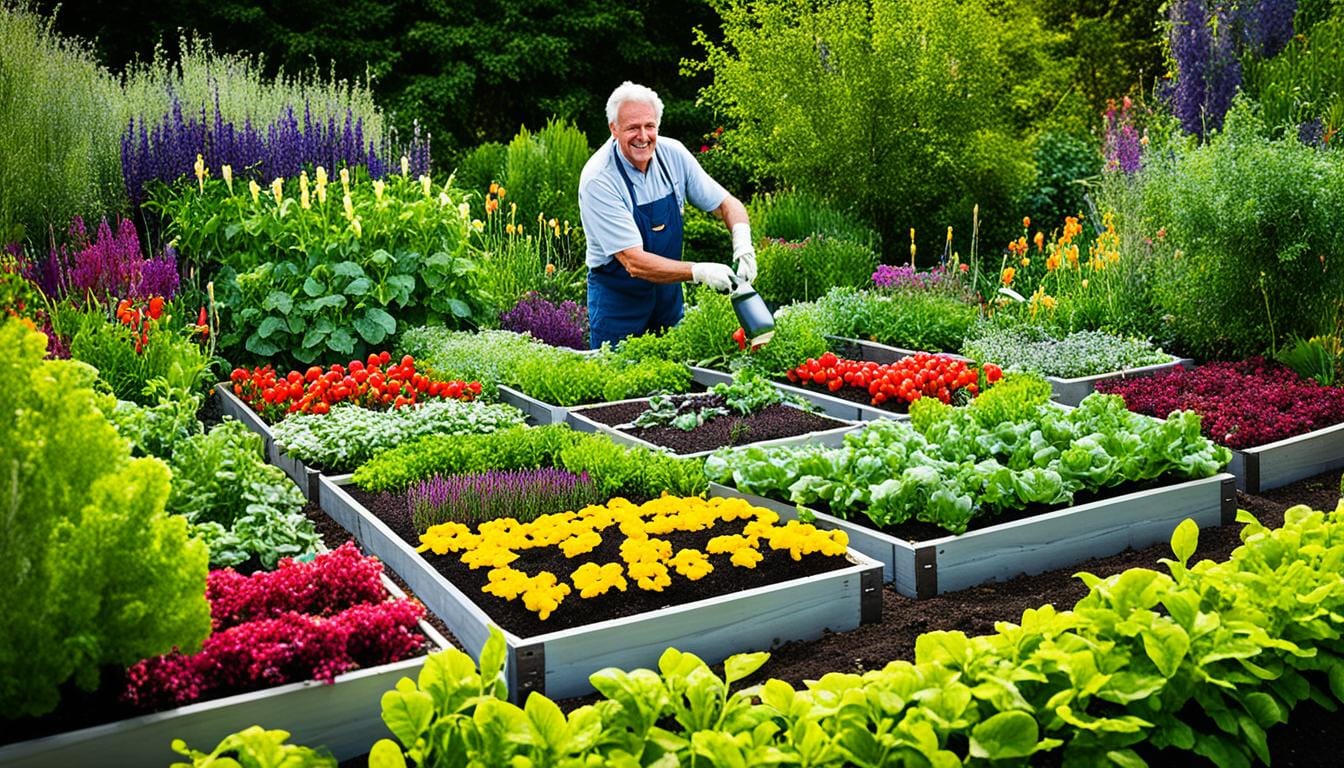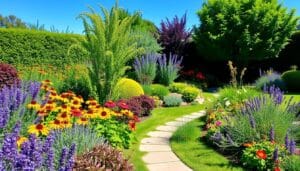Embracing raised bed gardening can turn your outdoor area into a lush oasis. It’s great for both experienced and new gardeners. This guide will give you the key tips to make a thriving garden in your backyard. We’ll cover everything from preparing the soil to choosing plants and keeping your garden healthy.
Table of Contents

Key Takeaways
- Discover the benefits of raised bed gardening, including improved drainage, better soil quality, and reduced weed growth.
- Learn how to choose the right location and materials for your raised beds, tailoring them to your unique space and needs.
- Explore the various types of raised beds, from wooden frames to self-watering containers, and find the best option for your gardening style.
- Uncover the secrets to preparing your raised bed for optimal plant growth, including soil selection and amendment strategies.
- Master the art of crop selection and companion planting to maximize your garden’s productivity and diversity.
What is Raised Bed Gardening?
Raised bed gardening is a great way to grow plants, vegetables, and flowers. It uses wooden frames or strong materials for elevated beds. This method is perfect for both new and experienced gardeners.
Definition and Benefits
A raised bed is a garden area that’s higher off the ground. It has better soil, good drainage, and is easy to get to. This way of gardening gives plants a better place to grow, making them healthier and more productive. The main benefits include:
- Improved soil quality: You can pick the best soil mix for your plants.
- Enhanced drainage: Raised beds keep water from pooling, helping roots grow strong.
- Easier accessibility: Raised beds are at a good height, making gardening less hard on your back.
- Extended growing season: They warm up the soil early and keep it warm longer, letting plants grow longer.
Types of Raised Beds
There are many kinds of raised beds, each with its own perks:
| Type of Raised Bed | Description | Advantages |
|---|---|---|
| Wooden Raised Beds | Uses wood like cedar or treated lumber. | Strong, can be customized, and fits many garden styles. |
| Metal Raised Beds | Constructed from galvanized steel or other metals. | Long-lasting, doesn’t rust, and looks modern. |
| Repurposed Containers | Uses old containers like troughs or wine barrels. | Cost-saving, unique, and good for the planet. |
No matter the type, raised beds bring many benefits to gardening. They help gardeners grow a successful garden. By knowing about raised beds, you can pick the best one for your garden.

Preparing Your Raised Bed
Starting a raised bed garden means getting ready the right way. Picking the perfect spot and the best soil and additives are key. These steps lay the groundwork for your garden’s success.
Choosing the Right Location
When picking a spot for your raised bed, think about sunlight, easy access, and drainage. Look for a place that gets at least 6 hours of direct sunlight daily. Most plants love the sun to grow well.
Make sure it’s easy to get to for upkeep and picking. And, skip areas that stay wet, as good drainage is key for healthy plants.
Selecting Soil and Amendments
The soil in your raised bed is crucial for a great garden. Begin with a top-notch, nutrient-packed soil mix made for raised beds. Then, add raised bed soil additives like compost or aged manure. These improve the soil’s richness and its ability to hold water.
| Soil Characteristic | Ideal Condition |
|---|---|
| Texture | Loose, well-draining |
| pH | Slightly acidic (6.0-6.8) |
| Nutrient Content | High in organic matter |
By taking the time to prepare your raised bed well, you’ll give your plants the best chance to flourish. This means more delicious produce for you.

Raised Bed Gardening: Tips for Success
Raised bed gardening has many benefits, like better soil and less weeds and pests. Here are some top tips and techniques for a successful garden.
Optimal Planting Spacing
When you’re raised bed gardening, it’s important to space your plants right. Don’t put too many plants together. This helps with air flow and stops plants from fighting over water and nutrients.
Watering Strategies
Getting your raised bed gardening plants the right amount of water is key. Keep the soil moist but don’t soak it. Think about using a drip system or soaker hose for watering.
Weed Management
Weeds can quickly take over a raised bed. Use raised bed gardening best practices by pulling weeds often. You can also use mulch to stop weeds from growing.
Pest Control
Pests can be a problem in gardens, including raised beds. Use raised bed gardening advice and natural ways to keep pests away. Try companion planting, beneficial insects, neem oil, or insecticidal soap.
By using these raised bed gardening hacks, you’ll have a garden that’s full of life and gives you fresh, healthy food for years.

Crop Selection and Planting
Choosing the right crops and using companion planting are key to a successful raised bed garden. Raised beds offer many options for gardeners, each with unique benefits and needs.
Ideal Plants for Raised Beds
Leafy greens like kale, spinach, and lettuce do great in raised beds. They love the rich, well-drained soil and don’t take up much space. Other top choices include radishes, carrots, and cherry tomatoes.
Herbs such as basil, rosemary, and thyme are perfect for raised beds too. They add flavor and fragrance. Bush beans and peas are also great, using vertical space well.
Companion Planting Strategies
Companion planting puts different plants together to create a balanced garden. This method boosts nutrient uptake, keeps pests away, and attracts beneficial insects. For instance, marigolds near tomatoes ward off nematodes. Borage and calendula draw in pollinators and pests-eaters.
By picking the right crops and using companion planting, your raised bed garden can thrive. This approach ensures a rich harvest.

| Crop | Benefits for Raised Beds | Companion Plants |
|---|---|---|
| Leafy Greens (Kale, Spinach, Lettuce) | Compact growth, thrive in nutrient-rich soil | Carrots, Radishes, Beets |
| Tomatoes | Produce well in raised beds, can be trained to climb | Basil, Marigolds, Borage |
| Herbs (Basil, Rosemary, Thyme) | Flavorful additions, compact growth habit | Tomatoes, Peppers, Carrots |
| Bush Beans and Peas | Vertical growth maximizes limited space | Carrots, Radishes, Marigolds |
Conclusion
This guide on raised bed gardening has shown us its many benefits for gardeners at all levels. By using the tips and strategies shared here, you can start a successful raised bed garden in your backyard.
Raised bed gardening improves soil quality, helps with water management, and makes maintenance easier. It’s a great way to make the most of your garden space, no matter the size or soil type.
There are many advantages to raised bed gardening. You’ll see better plant growth, more produce, fewer weeds, and better pest control. If you’re new to gardening or want to improve your garden, this method is a great choice. Start a raised bed garden and enjoy growing a beautiful, productive garden in your own yard.
FAQ
What is the ideal size for a raised bed?
The best size for a raised bed is usually 3 to 4 feet wide. This makes it easy to reach the middle without harming the soil. You can make it as long as you like, but 6 to 8 feet is a good size for most people.
How deep should a raised bed be?
Raised beds should be 6 to 12 inches deep. This depth is perfect for most plants’ roots. For deeper-rooted plants like carrots or parsnips, go for a 12-inch depth.
What are the best materials to use for a raised bed?
Good materials for raised beds are untreated cedar, redwood, or pine. They’re strong and don’t rot easily. You can also use metal, composite lumber, or old bricks. Just pick something safe for growing food.
How do I prepare the soil for a raised bed?
Start by clearing the area of weeds and old plants. Then, add lots of compost or well-rotted organic matter. This improves the soil’s health and fertility. Adding perlite or vermiculite can also help with drainage and air in the soil.
How often should I water my raised bed?
How often you water depends on the weather, plants, and soil type. Keep the soil moist but not soaked. In hot, dry times, you might need to water more. In cooler, wetter times, you can water less. Watch the soil and adjust your watering as needed.
What are some good companion plants for a raised bed garden?
Growing different plants together can help your garden. Marigolds keep pests away, basil makes tomatoes taste better, and nasturtiums attract good bugs. Try different plants together to see what works best for you.





